

A consequence is that spatial cognition-broadly defined here as spatial perception, memory, short-term decision-making, and planning in the service of navigation-reflects adaptations to these pressures at all levels of psychological description. Species-specific selection pressures have equipped animals with a range of navigation skills attuned to their specific requirements, including homing ( 3), migration ( 4), and exploiting spatiotemporal patterns of food distribution ( 5– 10). We conclude that virtual environments can allow for standardized testing with higher ecological validity than traditional tests in captivity and harbor great potential to contribute to longstanding questions in primate navigation, e.g., the use of landmarks, Euclidean maps, or spatial frames of reference.Īlmost all animals navigate within their environment to achieve goals of finding food, shelter, and mates ( 1, 2). The chimpanzees exhibited signature behaviors reminiscent of real-life navigation: They learned to approach a landmark associated with the presence of fruit, improving efficiency over time they located this landmark from novel starting locations and approached a different landmark when necessary. We presented six chimpanzees with a seminaturalistic virtual environment, using a custom touch screen application. Virtual reality technology combines the best of both worlds by creating large-scale, controllable environments. Captive research enables experimental control, but space restrictions can limit generalizability. Field research is ecologically valid, but controlling confounding variables can be difficult. Spatial cognition of nonhuman primates in large-scale environments is notoriously difficult to study. “Watching him paint was like witnessing the birth of art.Almost all animals navigate their environment to find food, shelter, and mates. “Congo’s ability to make a controlled abstract pattern and then to vary it in different ways meant that inside the ape brain there was already an aesthetic sense-very primitive but nevertheless present in a non-human species,” Morris tells artnet News over email.

In other words, it was the first time Congo made a purely artistic decision. The red, black, and yellow canvas from 1957 marked the first time Congo altered his classic fanned out pattern-a gesture apes make when spreading out leaves for a nest-in the name of composition. He’s holding onto one painting, though: Split Fan Pattern with Central Black Spot.

(The majority of Congo’s works were sold in 1957 after appearing in the Morris-curated exhibition “Paintings by Chimpanzees” at the Institute of Contemporary Arts in London.) “I now would rather that the paintings and drawings be made available to other collectors, to whom I hope they will bring as much pleasure as they have to me,” says Morris of his decision to part with his collection now. Congo died from tuberculous in 1964 at the age of 10. Morris’s findings were collected in his seminal 1967 book The Naked Ape: A Zoologist’s Study of the Human Animal.


 0 kommentar(er)
0 kommentar(er)
